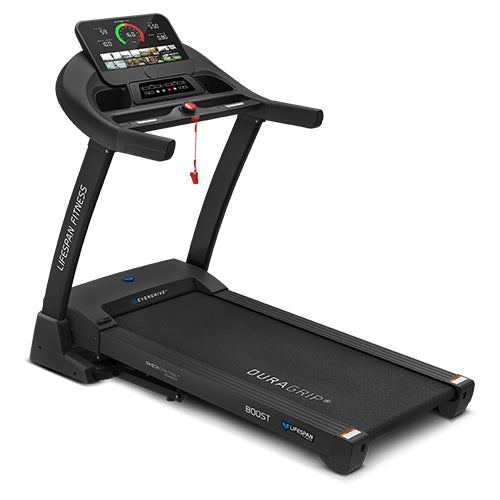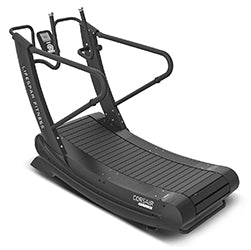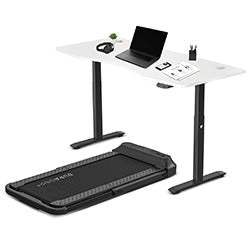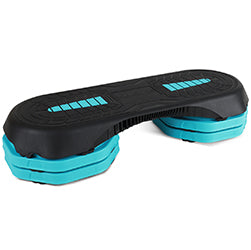

When it comes to starting a treadmill workout you may wonder what speed to walk or run at. You don’t want to set the speed too high and overdo it, but you also don’t want to move too slow and miss making the most out of your session. The ‘ideal’ speed to set your treadmill at is relative to each individual and their current fitness level. To know what level you are at, monitor your heart rate and breathing rate while on the treadmill. Your heart rate while exercising should be between 60-80% of your maximum heart rate.
To reap the benefits of treadmill training, your workout should feel challenging but not so hard that you feel exhausted after 5 minutes. Your ideal pace should accelerate your heart rate and breathing as well as create a sweat. Adjust your speed up or down according to how you feel. Adjusting your speed throughout your workout is necessary to avoid getting burnt out, if you are going for a longer workout, a slower pace and more breaks will be required. As your fitness levels improve you will be able to run faster and for longer.
Find out more on our blog: How long should I run for?
Optimal Treadmill Speeds for Beginners
The great thing about treadmills is they allow you to easily adjust your pace from a walk, to a jog, run or sprint. Speed buttons on your console or handles make it easy to adjust your pace mid run through single increments or pre-set levels. You may wonder 'what speed should I run on treadmill'. The answer will depend the type of treadmill workout you are undertaking.
Walking:
For beginners a good starting pace for walking should be less than 5km/h. Every treadmill workout should start and end with a walk to allow the body to warm up or cool down. Going straight into a sprint before warming up can cause injury and unnecessary stress on your muscles.
Jogging:
Increasing your speed and taking your walk to a jog should be the next step if you are a walking pro. Jogging speed should be set between 5.5 - 7km/h. Jogging provides a medium intensity cardio workout that is effective in keeping you fit and shedding extra calories.
Running:
Running can be difficult to get good at or accustomed to if you are starting off. However, the effort and perseverance pay off with incredible weight loss benefits. Running too fast is going to leave you feeling exhausted and burnt out very quickly. Good treadmill training is pacing yourself and gradually increasing your speed. You may ask how fast is speed 9 on the treadmill? Level 9 is a good high intensity running speed, most users' running speed will range between 8km-12km.
Sprinting:
Sprinting is a great way to push yourself and break a sweat. Sprints should be high intensity, short burst efforts, keeping sprints to 30 seconds is suggested. Sprinting speed ranges from 20km/h to 24km/h. However, not all treadmills reach this speed, an advanced treadmill will be needed to increase your speed to this range. Running at a high pace can be dangerous if you go straight into sprinting without any jogging or running prep. Since sprinting is a high impact exercise, it is important to increase your pace gradually to avoid fatigue, injury or joint pain.
Treadmill Training Benefits
You may wonder what does running on a treadmill do to your body? A treadmill workout comes with heaps of fitness benefits that can be conveniently achieved in your home. Treadmills offer great versatility allowing you to walk, jog, run and complete uphill climbs all on one machine.
Weight Loss:
One of the biggest appeals of a treadmill is its ability to burn fat. The high impact machine helps you burn calories quicker than other forms of aerobic exercise. Interval training, whereby you alternate between running and walking is one of the most effective ways to quickly and safely reduce body fat. Low intensity workouts will deliver the same results over a longer period of time.
Build Muscle:
In addition to burning calories, treadmills are also great machines for building muscle and strengthening your lower body. Leg muscles including your quads, calves and glutes are activated during a walk or run, increasing the treadmills incline and speed will further engage these muscle groups. Pairing a treadmill workout with free weights such as a pair of dumbbells will create a greater resistance for your legs.
Heart Health:
Treadmills are a popular form of cardiovascular exercise that can improve your heart health. Walking or running on the treadmill is shown to be effective in increasing your heart rate to a healthy level, enabling you to easily perform other exercises including weight and functional training. It is suggested that as your heart rate accelerates it helps boost blood circulation which in turn reduces your blood pressure, thereby keeping your risk of heart disease lower.
Does treadmill speed translate to real world running?

Although running outdoors and on a treadmill may feel like the same thing, there are a few variables that come into play affecting your ability to replicate your treadmill speed in outdoor running and vice versa. Running outdoors is typically more difficult than running indoors, this is mainly due to wind resistance. As you’re running outdoors, the wind and air create a resistance making you work harder to pick up speed. On the treadmill this resistance doesn’t exist. Stimulating the resistance of running outdoors can be done on the treadmill by increasing the incline 1% to mimic the oxygen cost of running outdoors. The weather and running surface will also impact your outdoor run, for example it would be difficult to maintain your treadmill running speed when running on the beach on a blistering hot day.
Maintaining a consistent running speed is easier on a treadmill as you have the moving running belt forcing you to keep up with your set pace. There is also no room to unintentionally slow down without changing your speed. This makes it easier to work towards your running goals and prepare for long duration runs.
Find out more in our blog: Is treadmill speed the same as real speed?
Conclusion
Treadmill running doesn’t come naturally to all, it will take time and practice to gradually work up your running speed. Building up your speed will start from first nailing lower speeds. It is important to not push yourself too hard and know your limits. Above is a guideline for average speeds when walking, jogging, running and sprinting. However, what will feel comfortable and within your fitness capabilities will be different for everyone. The first step is getting started, then you can experience all the health and fitness benefits a treadmill workout has to offer.

















































